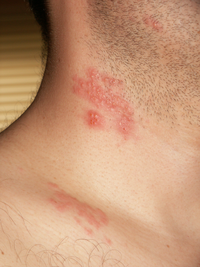
Photo from wikipedia
Invasive candidiasis occurs frequently in hospitalized patients, and is associated with high mortality rates due to delays in recognition and initiation of appropriate antifungals. Management of invasive candidiasis must take… Click to show full abstract
Invasive candidiasis occurs frequently in hospitalized patients, and is associated with high mortality rates due to delays in recognition and initiation of appropriate antifungals. Management of invasive candidiasis must take into account multiple host, pathogen, and drug-related factors, including the site of infection, host immune status, severity of sepsis, resistance and tolerance to antifungal agents, biofilm formation, and pharmacokinetic/pharmacodynamic considerations. Recent treatment directives have been shaped by the widespread introduction of echinocandins, highly potent and safe antifungals, into clinical use, as well as important changes in drug susceptibility patterns and the emergence of known and novel drug-resistant Candida species. Advances in molecular diagnostics have the potential to guide early targeted treatment of high-risk patients.
Journal Title: Journal of Fungi
Year Published: 2018
Link to full text (if available)
Share on Social Media: Sign Up to like & get
recommendations!